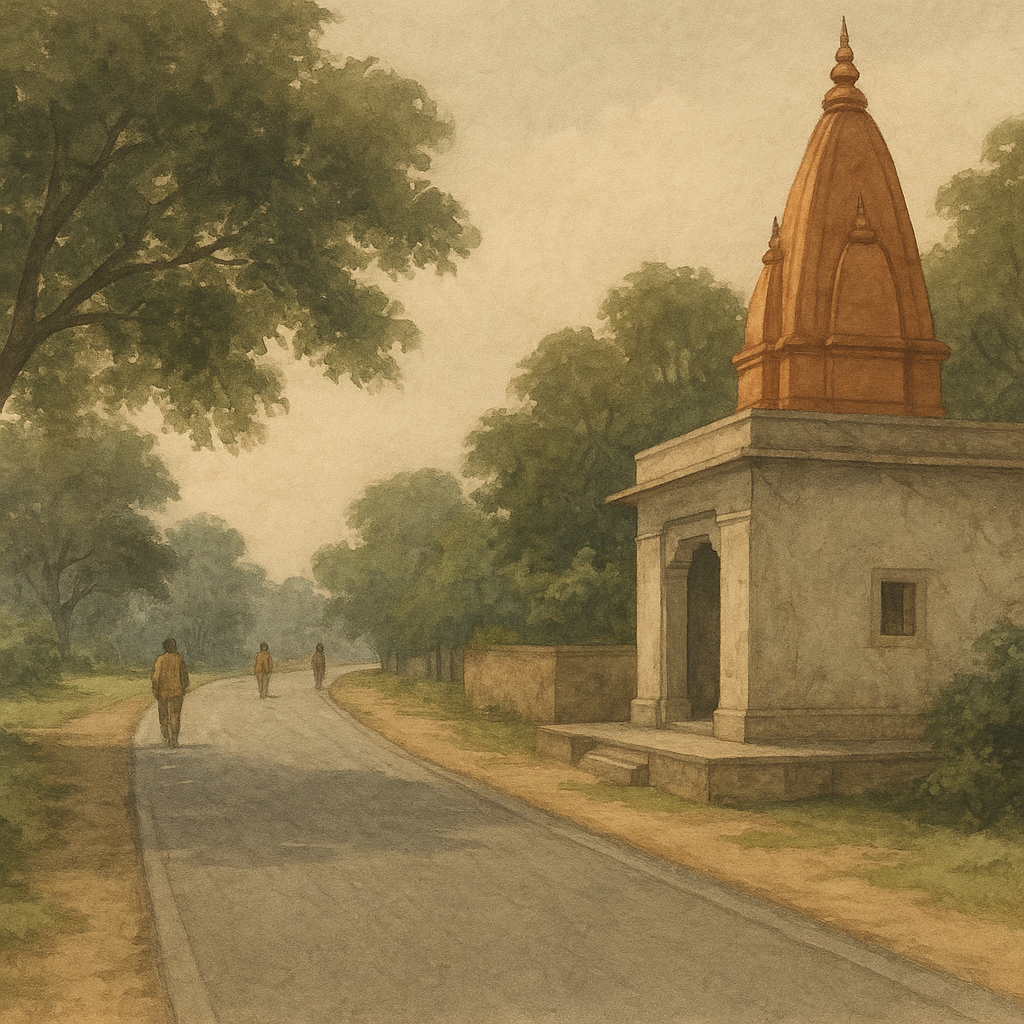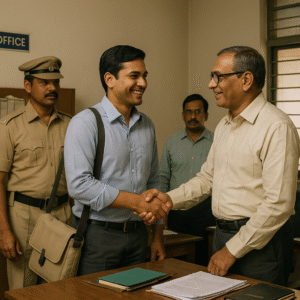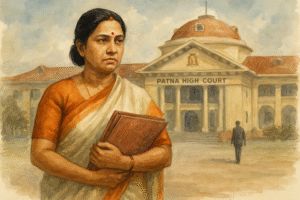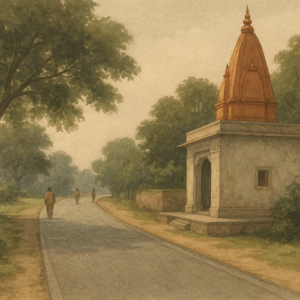The Patna High Court, in a Letters Patent Appeal decided on 07 November 2022, examined whether a religious head (mahanth) could claim compensation from the State when a public road was constructed over land said to be part of a Math/religious institution, even though (i) the road had been in existence for nearly two decades, and (ii) title over the land itself was under dispute before a civil court. The Court ultimately refused to interfere with the order of the Single Judge and held that the appellant’s claim for compensation was premature and unsustainable in the present form. The Court also underlined an important principle: when public infrastructure is created long ago and is being used by the public, a late and individual claim based on presumed ownership—especially where title is still unsettled—cannot easily dislodge that public use.
Simplified Explanation of the Judgment
This appeal arose from a grievance made by the appellant (a religious functionary heading a Math) that land around a pond, said to belong to the Math, was taken and used for construction of a pucca public road. The appellant said the road was built at government cost and was now being used by the public at large, but no consent of the Math was ever taken, nor was any compensation given. He, therefore, approached revenue and grievance redressal authorities, and when his requests were not acted upon, he filed a writ petition before the Patna High Court. That writ petition was dismissed, and the present Letters Patent Appeal was filed against that dismissal.
Before the High Court, it was not in dispute that the road exists, that it is a pucca road, and that it is being used by the public. It was also not disputed that the land in question surrounds a pond and its embankment, and forms part of a larger property said to belong either to the Math or to the Bihar State Board of Religious Trusts. What was crucial, however, was the fact that the ownership of this land had already been the subject of a title suit—Title Suit No. 243 of 1987—filed long ago. In that suit, the civil court had held that the land was trust property and not the personal property of the Math as claimed. That finding is under challenge in a pending appeal. In other words, when the appellant came to the High Court in writ jurisdiction and then in appeal, the title over the land was “still in a flux,” to use the Court’s expression.
The Division Bench pointed out another significant aspect: the road was constructed nearly 17–18 years before the writ petition was filed. That means the public road existed for about two decades before the challenge was made. There was nothing on record to show that, at the time of construction, any objection was raised by the Math, by the appellant, or by anyone claiming through the religious institution. In such a situation, the Single Judge had taken a practical view—if the Math or its head stood by silently when the State constructed a public road at public expense, and allowed the public to use it for years, a presumption of consent could be drawn. Not a legal presumption in the strict sense, but a reasonable inference from long inaction. On this basis, the writ petition was dismissed. The Division Bench, while noting that normally property rights cannot be taken away on presumed consent and that consent regarding religious or trust property should ideally be in writing, still found no reason to disturb the conclusion of the Single Judge in the facts of this case.
The appellant tried to argue that his basic complaint was different: he only wanted the administrative authorities to implement the direction of the Commissioner, who had earlier asked the Circle Officer to inquire whether the road had indeed been built on Math property and, if so, whether consent was taken. That direction, according to the appellant, was never carried to its logical end. But the Division Bench took a wider view. It noted:
- The writ petition and the appeal were not filed in the name of the Math (which would be the real owner, if at all, depending on the result of the title appeal);
- The construction was old and had never been questioned contemporaneously;
- The title suit findings were against the Math side, and the appeal from that suit was still pending; and
- Even if the appellant ultimately won the title appeal, it would still be difficult, after two decades of public use, to prove that no consent was ever taken.
So, the Court said, in effect: this is not the stage to grant compensation, and this is not the proper vehicle to reopen a long-standing public road. The appellant should first await the result of the civil appeal concerning title. If he succeeds there and firmly establishes that the land belongs to the Math/trust, he may then be in a better position to raise a lawful claim. Until then, the Court would not disturb an order that has the effect of preserving public access and avoids unsettling an old public work. The Letters Patent Appeal was, therefore, disposed of without interfering with the Single Judge’s order.
Significance or Implication of the Judgment
- For religious/trust institutions in Bihar: The case is a reminder that, where the State has constructed a public facility on land claimed by a religious institution, any challenge or demand for compensation must be timely, and must be backed by clear title. Long silence can seriously weaken the claim.
- For government authorities: Even though the Court upheld the dismissal, it also made an important observation: consent for use of private or trust land should not be presumed; it should preferably be written, especially when religious/trust property is involved. This is a caution for future acquisitions or uses.
- For the general public: Once a road has been used by the public for many years, the Court is slow to disturb such use, especially when the claimant’s own title is under dispute. Continuity of public infrastructure is an important consideration.
- For pending title disputes: The Court has clearly said: first resolve title, then pursue consequential reliefs like compensation or restitution.
Legal Issue(s) Decided and the Court’s Decision with Reasoning
- Whether the appellant could seek compensation for land over which a public road was built nearly two decades earlier, when the title over that land was itself under challenge.
➤ Decision: No compensation at this stage. The Court said the appellant should await the result of the title appeal, since ownership is not settled. - Whether the writ petition/appeal could be maintained by an individual religious functionary rather than the Math/trust, which would be the actual owner if the civil appeal succeeds.
➤ Decision: The Court treated this as a weakness in the appellant’s case and noted that neither the writ nor the appeal had been filed on behalf of the Math. - Whether long delay and absence of contemporaneous objection can lead to an inference that the construction was with consent or at least without opposition.
➤ Decision: Yes, in the factual background of this case. The Court noted the construction was 17–18 years old and there was “no documentation of any challenge whatsoever.” - Whether public authorities acted illegally when they did not straightaway compensate the appellant.
➤ Decision: No interference required. Since title is unsettled and the road is long-standing, the Court declined to issue any direction for compensation now.
Judgments Referred by Parties (with citations)
- Not specifically recorded in the text available.
Judgments Relied Upon or Cited by Court (with citations)
- The Court primarily relied on the factual background, especially the finding of the civil court in Title Suit No. 243 of 1987 (holding that the land was trust property), which is under appeal. This pending appeal was the major reason for not granting compensation now.
Case Title
- Mahanth/Religious Head of the Math v. State of Bihar & Others (real party names intentionally omitted for publication purposes)
Case Number
- Letters Patent Appeal No. 1 of 2020
- Arising out of C.W.J.C. No. 12003 of 2019
- Decision dated 07-11-2022 (Patna High Court)
Citation(s)
2023 (1) PLJR 9
Coram and Names of Judges
- Hon’ble Mr. Justice Ashutosh Kumar
- Hon’ble Mr. Justice Nawneet Kumar Pandey
(Oral judgment per Hon’ble Mr. Justice Ashutosh Kumar)
Names of Advocates and who they appeared for
- For the appellant (religious head): Mr. Rajendra Narain, Senior Advocate; Mr. Dineshwar Prasad Singh, Advocate
- For Respondent No. 7 (Bihar State Board of Religious Trust): Mr. Ganpati Tripurati (Trivedi in text), Senior Advocate (appeared at the Court’s request as the property was claimed to be that of the Board)
- For the State of Bihar: Mr. Sanjay Prasad, Advocate
Link to Judgment
MyMxIzIwMjAjMSNO-Ouiq–ak1–ylr5jg=
If you found this explanation helpful and wish to stay informed about how legal developments may affect your rights in Bihar, you may consider following Samvida Law Associates for more updates.








